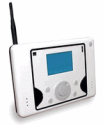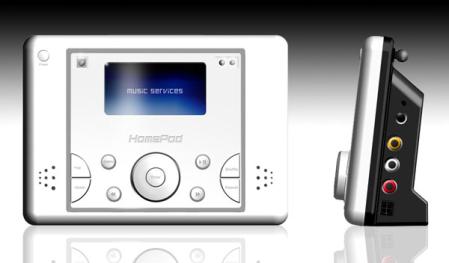Java-powered home audio device frees music files from computers
Dec 16, 2003 — by LinuxDevices Staff — from the LinuxDevices Archive — 15 views A new Java powered home entertainment audio device design promises to simplify sharing computer music files among computers and stereos in connected homes. Gloolabs's Gloo is Java middleware that puts an iPod-like interface on music files it “discovers” around the network. Gloo, which will be licensed to multiple device makers, is available now on one device that runs embedded Linux, and Gloolabs is currently bootstrapping a Gloo developer community.
A new Java powered home entertainment audio device design promises to simplify sharing computer music files among computers and stereos in connected homes. Gloolabs's Gloo is Java middleware that puts an iPod-like interface on music files it “discovers” around the network. Gloo, which will be licensed to multiple device makers, is available now on one device that runs embedded Linux, and Gloolabs is currently bootstrapping a Gloo developer community.
The Gloo middleware can theoretically run on any device that supports Java, and Gloolabs's first customer is MacSense, which built its $250 HomePod around embedded Linux and a hardware design of its own. Both MacSense and GlooLabs have hardware reference designs that device manufacturers can license.
Gloolabs is currently taking orders for the MacSense HomePod, which will ship in January 2004. A $350 Developer Edition is available now, but “will be gone within a week,” according to Gloolabs Director of Developer Relations Nate Saal.
Developer community
The Developer Edition of the MacSense HomePod, along with a software development kit (SDK) from Gloo expected to ship in January, offer Java hackers a chance to contribute interfaces, applications, and services to the platform, according to Saal. “If you're a Java developer, we will provide you with the source code. You can make an alarm clock with a different song for every day of the week, or a song rating service, or an interface to Internet shoutcast station content, or . . .?”
The Developer Edition HomePod is available initially direct from Gloolabs and includes:
- Linux login capabilities
- Access to communication tools (Telnet, FTP, etc.)
- Access to hardware API's (LCD, buttons, speakers, etc.)
- Access to GLOO developer community (with access to GLOO development team)
- Access to firmware (Linux Kernel, C source for drivers, Java source for applications)
- make files for easy updating of the firmware
Gloolabs will launch a developer community and standalone SDK the first week of January, according to Saal. The SDK will include a hardware emulator, enabling developers to hack Gloo on their desktops, regardless of whether they have purchased any hardware.
Developers will be able to distribute their code through the Gloolabs developer Website, according to Saal, although no provisions for commerce have been made at this time. Owners of the MacSense HomePod and other Gloo-based devices will be able to install third-party software and updates from Gloo using a “firmware upgrade” tool in their device's web-based interface.
One, two, Gloo
Out of the box, the Gloo middleware comprises three functional elements: a “player” implemented in firmware can handle MP3; Internet Radio (now); AAC, WAV, and soon, WMA files.
A “desktop server” component acts as a streaming media and audio server. It supports various kinds of playlists, including MusicMatch Jukebox, WinAmp, and iTunes, as well as simple file listings from a number of different operating systems (see full specs below).
A “remote control” component finds all libraries of usable music files on connected computers, as well as all players, and controls them. “It could be used for parental control,” notes Saal. “As in 'turn that [email protected]#$!*% thing down!'”? we asked. “Exactly.”
According to Saal, Gloolabs also plans to market Gloo software for use directly on a laptop or PDA.
The MacSense HomePod
The MacSense HomePod device includes small stereo speakers, as well as interfaces for connection to home audio equipment. It features rather impressive audio circuitry and a “zero moving parts” design that minimizes noise. Claimed audio specs include a 24-bit, 96kHz Delta-Sigma Digital Analog Converter (DAC) with a frequency response of 20Hz-20KHz+/-0.2dB and a signal/noise ratio of 102dB.

MacSense's HomePod features a table-radio like design and an iPod-esque jog-dial
Other hardware features in the MacSense HomePod design include:
- Toshiba TX4926 200MHz CPU
- 16MB Flash RAM, 32MB SDRAM
- 802.11b 11Mbps mini-PCI Card with external antenna
- RJ-45 10/100Base-T Ethernet Port
- Left and right and headphone audio ports
- Built-in stereo speakers
- Digital coaxial and SPDIF ports
- USB port, host-powered
- FM tuner with wire antenna
- 124x64pixel back-lit blue LCD display
- Jog-shuttle rotating dial
- Web-configurable and upgradable firmware
- IR and IrDA ports
- 18-key remote control
- Unicode support for song titles in double-byte languages
- Supported Media Manager:
- Apple iTunes, MusicMatch Jukebox, Nullsoft WinAmp, Microsoft MediaPlayer
- Networked PC OS Support:
- Mac OS 8, 9, X, Windows 98/Me/2000/XP, Linux, BSD and Solaris
- Supported Audio Formats:
- MP3, Internet Radio (now), AAC, WAV, WMA (soon)
- Note: Apple Music Store AAC files not supported due to DRM
- GLOO Software:
- The core Java-based embedded programs that handle the discovery, request, transfer, and control of audio content on HomePod. Gloo Server and Gloo Remote Control.
OK, how do I get one?
Gloolabs is now taking orders for two versions of the MacSense HomePod device. The $250 standard version can be ordered now for January 2004 delivery, and a limited quantity of the $350 Developer Version is currently shipping.
This article was originally published on LinuxDevices.com and has been donated to the open source community by QuinStreet Inc. Please visit LinuxToday.com for up-to-date news and articles about Linux and open source.